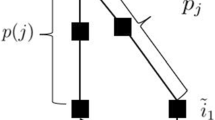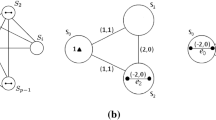Abstract
Definition of an optimal path in the real-world routing problems is not necessarily the shortest one, because parameters such as travel time, safety, quality, and smoothness also played essential roles in the definition of optimality. In this paper, we use bi-colored graphs for modeling urban and heterogeneous environments and introduce variations of constraint routing problems. Bi-colored graphs are a kind of directed graphs whose vertices are divided into two subsets of white and gray. We consider two criteria, minimizing the length and minimizing the number of gray vertices and present two problems called gray vertices bounded shortest path problem and length bounded shortest path problem on bi-colored graphs. We propose an efficient time label-setting algorithm to solve these problems. Likewise, we simulate the algorithm and compare it with the related path planning methods on random graphs as well as real-world environments. The simulation results show the efficiency of the proposed algorithm.








Similar content being viewed by others
Notes
A more detailed bibliography is available in http://www.ics.uci.edu/∼eppstein/bibs/kpath.bib
References
LaValle SM (2006) Planning algorithms. Cambridge University Press, Cambridge
Turner L, Hamacher HW (2011) On Universal Shortest Paths. Springer Berlin Heidelberg, pp 313–318
Gourvès L, Lyra A, Martinhon C, Monnot J, Protti F (2009) On s-t paths and trails in edge-colored graphs. Electronic Notes in Discrete Mathematics 35:221–226. https://doi.org/10.1016/j.endm.2009.11.037
Garey MR, Johnson DS (1979) Computers and intracability: A guide to the theory of NP-completeness. W.H. Freeman, New York, NY, USA
Silva R, Craveirinha J (2004) An Overview of routing models for MPLS Networks. In: 1st Workshop Multicriteria Modelling in Telecommunication Network Planning and Design. Faculty of Economics of the University of Coimbra, Coimbra, Portugal, pp 17–24
Festa P (2015) Constrained shortest path problems: state-of-the-art and recent advances. In: 2015 17th International Conference on Transparent Optical Networks (ICTON). IEEE, pp 1–17
Davoodi M (2017) Bi-objective path planning using deterministic algorithms. Robotics and Autonomous Systems 93:105–115. https://doi.org/10.1016/j.robot.2017.03.021
Davoodi M, Panahi F, Mohades A, Hashemi SN (2013) Multi-objective path planning in discrete space. Applied Soft Computing 13:709–720. https://doi.org/10.1016/J.ASOC.2012.07.023
Jaffe JM (1984) Algorithms for finding paths with multiple constraints. Networks 14:95–116. https://doi.org/10.1002/net.3230140109
Lorenz DH, Raz D (2001) A simple efficient approximation scheme for the restricted shortest path problem. Operations Research Letters 28:213–219. https://doi.org/10.1016/S0167-6377(01)00069-4
Hassin R (1992) Approximation Schemes for the Restricted Shortest Path Problem. Math Oper Res 17:36–42. https://doi.org/10.1287/moor.17.1.36
Dumitrescu I, Boland N (2001) Algorithms for the Weight Constrained Shortest Path Problem. International Transactions in Operational Research 8:15–29. https://doi.org/10.1111/1475-3995.00003
Dumitrescu I, Boland N (2003) Improved Preprocessing, Labeling and Scaling Algorithms for the Weight-Constrained Shortest Path Problem. Networks 42:135–153. https://doi.org/10.1002/net.10090
Chen S, Song M, Sahni S (2008) Two techniques for fast computation of constrained shortest paths. IEEE/ACM Transactions on Networking 16:105–115. https://doi.org/10.1109/TNET.2007.897965
Santos L, Coutinho-Rodrigues J, Current JR (2007) An improved solution algorithm for the constrained shortest path problem. Transportation Research Part B: Methodological 41:756–771. https://doi.org/10.1016/j.trb.2006.12.001
Ergun F, Sinha R, Zhang L (2002) An improved FPTAS for Restricted Shortest Path. Information Processing Letters 83:287–291. https://doi.org/10.1016/S0020-0190(02)00205-3
Chen G, Xue G (2003) A PTAS for weight constrained Steiner trees in series–parallel graphs. Theoretical Computer Science 304:237–247. https://doi.org/10.1016/S0304-3975(03)00088-4
Xin Yuan, Xingming Liu (2001) Heuristic algorithms for multi-constrained quality of service routing. In: Proceedings IEEE INFOCOM 2001. Conference on Computer Communications. Twentieth Annual Joint Conference of the IEEE Computer and Communications Society (Cat. No.01CH37213). IEEE, pp 844–853
Zheng Wang, Crowcroft J (1996) Quality-of-service routing for supporting multimedia applications. IEEE Journal on Selected Areas in Communications 14:1228–1234. https://doi.org/10.1109/49.536364
Tarapata Z (2007) Selected Multicriteria Shortest Path Problems: An Analysis of Complexity, Models and Adaptation of Standard Algorithms. International Journal of Applied Mathematics and Computer Science 17:269–287. https://doi.org/10.2478/v10006-007-0023-2
Yen JY (1971) Finding the K shortest loopless paths in a network. Management Science 17:712–716. https://doi.org/10.1287/mnsc.17.11.712
Eppstein D (1998) Finding the k Shortest Paths. SIAM Journal on Computing 28:652–673. https://doi.org/10.1137/S0097539795290477
Akiba T, Hayashi T, Nori N, Iwata Y, Yoshida Y (2015) Efficient Top-k Shortest-path Distance Queries on Large Networks by Pruned Landmark Labeling. In: Proceedings of the Twenty-Ninth AAAI Conference on Artificial Intelligence. AAAI Press, pp 2–8
Burstein D, Metcalf L (2016) The K Shortest Paths Problem with Application to Routing. 1–37
Zhang S, Liu X (2013) A new algorithm for finding the k shortest transport paths in dynamic stochastic networks. Journal of Vibroengineering 15:726–735
Scano G, Huguet MJ, Ngueveu SU (2016) Adaptations of k-shortest path algorithms for transportation networks. In: Proceedings of 2015 International Conference on Industrial Engineering and Systems Management, IEEE IESM 2015. pp 663–669
Guo J, Jia L (2017) A new algorithm for finding the K shortest paths in a time-schedule network with constraints on arcs. Journal of Algorithms and Computational Technology 11:170–177. https://doi.org/10.1177/1748301816680470
Chondrogiannis T, Bouros P, Gamper J, Leser U (2017) Exact and Approximate Algorithms for Finding k-Shortest Paths with Limited Overlap. In: 20th International Conference on Extending Database Technology : EDBT 2017. pp 414–425
Wang S, Yang Y, Hu X, Li J, Xu B (2016) Solving the K -shortest paths problem in timetable-based public transportation systems. Journal of Intelligent Transportation Systems 20:413–427. https://doi.org/10.1080/15472450.2015.1082911
Eppstein D (1994) Finding the k shortest paths. In: 35th Annual Symposium on Foundations of Computer Science. IEEE, pp 154–165
Eppstein D, Gupta S (2017) Crossing Patterns in Nonplanar Road Networks. In: Proceedings of the 25th ACM SIGSPATIAL International Conference on Advances in Geographic Information Systems - SIGSPATIAL’17. ACM Press, New York, New York, USA, pp 1–9
Masucci AP, Smith D, Crooks A, Batty M (2009) Random planar graphs and the London street network. The European Physical Journal B 71:259–271. https://doi.org/10.1140/epjb/e2009-00290-4
Schultes D (2008) Route Planning in Road Networks. VDM Verlag
Zhang Y, Liu J, Qian X, Qiu A, Zhang F (2017) An Automatic Road Network Construction Method Using Massive GPS Trajectory Data. ISPRS International Journal of Geo-Information 6:400. https://doi.org/10.3390/ijgi6120400
Wang X, You S, Wang L (2017) Classifying road network patterns using multinomial logit model. Journal of Transport Geography 58:104–112. https://doi.org/10.1016/j.jtrangeo.2016.11.013
Gupta S (2018) Topological Algorithms for Geographic and Geometric Graphs. University Of California, Irvine Topological
Yang B, Guo C, Ma Y, Jensen CS (2015) Toward personalized, context-aware routing. The VLDB Journal 24:297–318. https://doi.org/10.1007/s00778-015-0378-1
Ceikute V, Jensen CS (2013) Routing Service Quality -- Local Driver Behavior Versus Routing Services. In: 2013 IEEE 14th International Conference on Mobile Data Management. IEEE, pp 97–106
Funke S, Storandt S (2015) Personalized route planning in road networks. In: Proceedings of the 23rd SIGSPATIAL International Conference on Advances in Geographic Information Systems - GIS ’15. ACM Press, New York, New York, USA, pp 1–10
Delling D, Wagner D (2009) Time-dependent route planning. In: Lecture Notes in Computer Science (including subseries Lecture Notes in Artificial Intelligence and Lecture Notes in Bioinformatics). Springer, Berlin, Heidelberg, pp 207–230
ter Mors AW, Witteveen C, Zutt J, Kuipers FA (2010) Context-Aware Route Planning. In: Lecture Notes in Computer Science (including subseries Lecture Notes in Artificial Intelligence and Lecture Notes in Bioinformatics). Springer, Berlin, Heidelberg, pp 138–149
Li PH, Yiu ML, Mouratidis K (2017) Discovering historic traffic-tolerant paths in road networks. GeoInformatica 21:1–32. https://doi.org/10.1007/s10707-016-0265-y
Geisberger R, Sanders P, Schultes D, Delling D (2008) Contraction hierarchies: Faster and simpler hierarchical routing in road networks. In: Lecture Notes in Computer Science (including subseries Lecture Notes in Artificial Intelligence and Lecture Notes in Bioinformatics). Springer Berlin Heidelberg, Berlin, Heidelberg, pp 319–333
Bast H, Delling D, Goldberg A, Müller-Hannemann M, Pajor T, Sanders P, Wagner D, Werneck RF (2016) Route Planning in Transportation Networks. In: Lecture Notes in Computer Science (including subseries Lecture Notes in Artificial Intelligence and Lecture Notes in Bioinformatics). pp 19–80
Ahmadi MH, Haghighatdoost V (2017) General Time-Dependent Sequenced Route Queries in Road Networks. In: 2017 IEEE 15th Intl Conf on Dependable, Autonomic and Secure Computing, 15th Intl Conf on Pervasive Intelligence and Computing, 3rd Intl Conf on Big Data Intelligence and Computing and Cyber Science and Technology Congress(DASC/PiCom/DataCom/CyberSciTech). IEEE, New York, New York, USA, pp 949–956
Dibbelt J, Strasser B, Wagner D (2015) Fast exact shortest path and distance queries on road networks with parametrized costs. In: Proceedings of the 23rd SIGSPATIAL International Conference on Advances in Geographic Information Systems - GIS ’15. ACM Press, New York, New York, USA, pp 1–4
Delling D, Goldberg A V, Pajor T, Werneck RF (2017) Customizable Route Planning in Road Networks. Transportation Science 51:566–591. https://doi.org/10.1287/trsc.2014.0579
Yu J, Zhang Z, Sarwat M (2018) Spatial data management in apache spark: the GeoSpark perspective and beyond. GeoInformatica. https://doi.org/10.1007/s10707-018-0330-9
Eldawy A (2016) SpatialHadoop: A MapReduce Framework for Big Spatial Data
Author information
Authors and Affiliations
Corresponding author
Additional information
Publisher’s note
Springer Nature remains neutral with regard to jurisdictional claims in published maps and institutional affiliations.
Rights and permissions
About this article
Cite this article
AliAbdi, A., Mohades, A. & Davoodi, M. Constrained shortest path problems in bi-colored graphs: a label-setting approach. Geoinformatica 25, 513–531 (2021). https://doi.org/10.1007/s10707-019-00385-8
Received:
Revised:
Accepted:
Published:
Issue Date:
DOI: https://doi.org/10.1007/s10707-019-00385-8




